President's Message
In the news for 2023:
We are pleased to welcome John Zannino as the recently appointed director of the Henrico County Division of Recreation & Parks. Mr. Zannino joined Recreation & Parks in 2007 as a recreation coordinator and later served as an assistant director of the Recreation Services Division. The Henrico History Section within the Division of Recreation and Parks researches, interprets, and develops programs on Henrico County history, one of which is the historic roadside marker and building plaque program. The historic roadside marker program promotes awareness of Henrico County history through the identification of historic sites. Historic plaques display the construction date of significant historical structures. Markers and plaques can be viewed at County Markers - Henrico County, Virginia For additional Information call (804)501-5123.
Congratulations and best wishes to Patricia O'Bannon in announcing her retirement as Supervisor of the Tuckahoe District. Mrs. O'Bannon, elected in 1995, was the first woman to serve on the Henrico County Board of Supervisors. We very much appreciate her support of Henrico history. Among her many accomplishments, she was instrumental in development of the site of Henricus Historical Park which recreates the second successful English settlement of the "Citie" of Henricus from which Henrico County traces its origin.
In 2009, the 2011 Commemoration Advisory Commission, a committee of citizens appointed by the Henrico County Board of Supervisors, began the planning of events and exhibitions to commemorate the 400th anniversary of the founding of Henrico. From this committee, subcommittees were formed to create activities on specific topics of Henrico history. The commission was chaired by Board of Supervisors member, Patricia S. O'Bannon.
We invite you to follow us on the Henrico County Historical Society Facebook page with another of our projects for the coming year. As part of planning the Henrico 400th anniversary commemoration, the "History Firsts Subcommittee" compiled a list of events and dates in Henrico history which we will be posting. The dates were sourced through the extensive research of Louis H. Manarin and Clifford Dowdey, which resulted in their publication of The History of Henrico County. First published in 1984, the book is no longer in print, but it is available in all Henrico County Public Libraries. We are told at some locations it is a reference book and may not be available for check out. Consult your local librarian for that information.
The book is dedicated to the children of Henrico County.
The 400th anniversary edition of The History of Henrico County written by Louis H. Manarin and Charles H. Peple is available for sale on the HCHS website shopping page at www.henricohistoricalsociety.org/shopping.html.
There are many goodwill activities in the communities of Henrico of which we may not be aware. In this coming year, we would like to feature people, businesses and organizations serving the community and making history.
We hope you will join us for the first quarterly meeting of 2023 on March 5. We look forward to hearing from speaker Peter Francisco. Peter and his wife, Sharon, are owners of Lakeside Farmers Market and are long-time members of the Society. They have been active in the Lakeside community for many years.
All people, places and things have a history.
History is the foundation from which there was progress to the present and onward to the future.
Sarah Pace,
President
>Back to Top<
March Quarterly Meeting
Come join us for our first meeting of the year!

Date and Start Time:
- Sunday, March 5th at 2:30 PM
Location:
- Belmont Recreation Center, 1600 Hilliard Rd, Richmond, VA 23228
Guest Speaker:
- Peter Francisco, Real Estate Broker
Topic:
- Peter will speak about The Lakeside historic District. He bought properties in the area, which in turn created business in Lakeside.

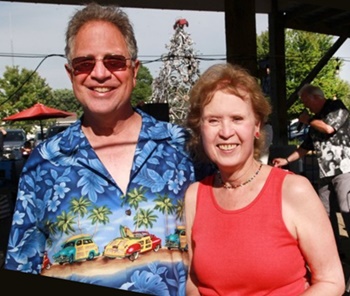
We look forward to seeing you there!
>Back to Top<
Welcome to John Zannino!
Henrico County Historical Society welcomes John Zannino, the new Henrico County Director of Recreation and Parks!

>Back to Top<
Inventive Henricoans
Leonard C. Lyzotte was a man who apparently loved his pie and wanted to ease the problem of handling those hot pie tins. The commercial success of his invention is unknown.
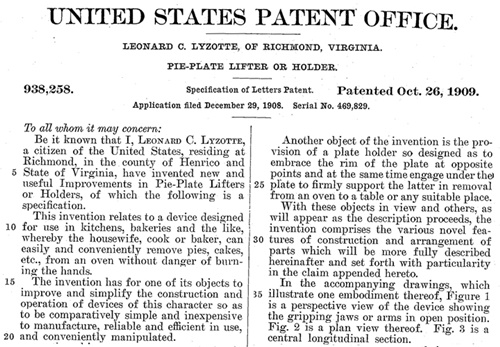
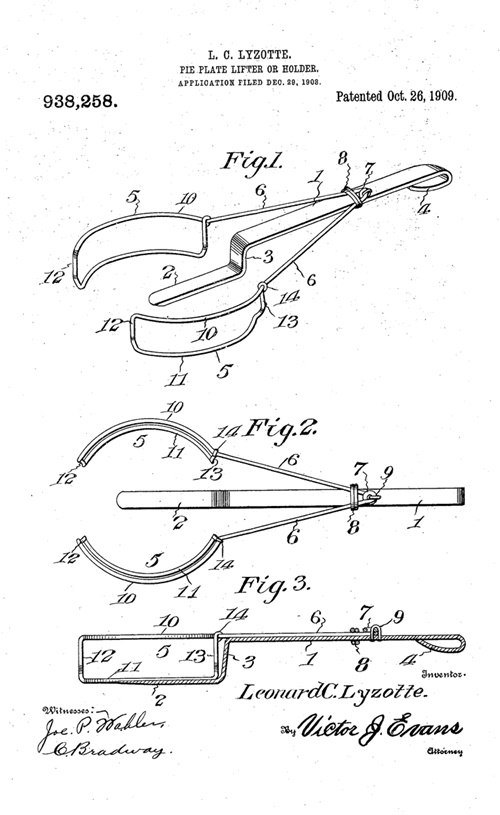
>Back to Top<
Once the Main Route to Petersburg, Osborne Turnpike is Today. . .The Road Less Traveled By
For years, part of my daily drive to Varina High School took me though downtown Richmond on East Main to Old Osborne Turnpike and on to Route 5. I always thought it odd that if I had gone straight at that junction that I would have left Old Osborne Turnpike and found myself on just plain Osborne Turnpike. That road didn't seem to be heading toward a destination that would have warranted a turnpike; but, in fact, it once did. In the late eighteenth and early nineteenth centuries, before good bridges spanned the James River, it was the shortest route from Richmond to Petersburg. That road was, as Henrico County Historical Marker HC-25 says, "one of the earliest artificial roads in the United States." It still leads to Osborne Landing, where a now longgone ferry would have transported early travelers across the narrow stretch of river to Osborne's Wharf near the village of Osbornes, or Osburns as some maps identified it. From there travelers could reach Petersburg.
Investors, like those who between 1802 and 1818 established seven other turnpike roads out of Richmond, saw the potential of the road to Osborne Landing and petitioned the General Assembly to form a turnpike company. In 1818, the General Assembly granted permission to the Richmond and Osborne Turnpike Company "for receiving subscriptions to the amount of fifty thousand dollars for the purpose of making a turnpike road from the city of Richmond to Osborne's in Chesterfield county, crossing James river where the same may be found to be most convenient."
By the next year, the turnpike was a reality; and the 1 June 1819 Richmond Enquirer carried a notice that said, "the Richmond and Osborn's [sic] turnpike road is so far completed as to admit being travelled on" and touted the "safe and expeditious boat on the river, near Osborne's." It went on to call it "the best road passing between Richmond and Petersburg" said it shortened the distance by five miles and indicated that its rates were "the same as at Mayo's Bridge." Curiously, it also added, "no toll charged on the road."
The act establishing the turnpike company had stipulated that tolls could be charged at the ferry, but mentioned no other tolls. However, O'Dell's Inventory of Early Architecture and Historic Sites identifies a spot just south of Kukymuth Road on today's Osborne Turnpike as the site of the toll house for the road. So we may assume that at some point tolls were collected, and those rates were regulated by the legislature. Three-year financial reports by the company would be made to the legislature, which, in general, allowed tolls that would result in no more than a fifteen percent profit.
Some company expenses came in unforeseen problems with construction. For example, contending with existing structures or problems in the landscape could run up the costs. To address one such problem, the company petitioned the General Assembly in 1821 to allow that a quarter-mile section of the road's width be altered from the required sixty feet to fifty feet at Powhatan Warehouse to conform to a street already laid out and also to reduce the width on a three hundred and fifty yard section just beyond the river on the Chesterfield side.
The Richmond and Osborne Turnpike became a popular and important route – important enough to carry the celebrated LaFayette and his entourage when they arrived at Osborne's on a journey from Norfolk to Richmond. But as the 29 October 1824 Richmond Enquirer noted, when the steamboat arrived, four members of Richmond's Committee of Arrangement who had traveled there in carriages went aboard and determined that the boat should continue to Rocketts. LaFayette did, however, travel the road when he left Richmond for Petersburg; and his reception at the ferry landing at Osborne's was quite elaborate. The 5 November 1824 Constitutional Whig said that he was met there by "a deputation and cavalry escort from Petersburg, with six carriages, one of which was an elegant Barouche with four Grey horses, intended for the General's accommodation."
Although the route was chosen for LaFayette, there was another alternative for travelers to Petersburg also being developed - the Manchester and Petersburg Turnpike. However, users from Richmond had to cross the James to get to Manchester. Mayo's Bridge, constructed around 1787 by John Mayo, did offer that possibility: but it had its drawbacks. According to Samuel Mordecai's Richmond in Bygone Days, it was constructed of "large logs, raftlike, spiked to the rocks, with rough floor laid on the logs" running out to Mayo's Island where the toll booth stood. The island was connected to the other bank by a "bridge of boats," a pontoon bridge comprised of a series of shallow boats tied together with rope and wood planks. Ice floes destroyed it the year after it was completed, and it was rebuilt. The destruction and rebuilding cycle continued, being repeated in 1814, 1816, 1823, 1870, 1877,1882 and 1889.
Since the 1823 bridge seems to have been substantial, the Manchester and Petersburg Turnpike became a major competitor to the Richmond and Osborne Turnpike; and, as we can see today, it eventually won out. By 1826, the directors of the Richmond and Osborne Turnpike petitioned the General Assembly for permission to connect to the Manchester and Petersburg Turnpike. It was granted, but the legislature stipulated that the connection's location could be "at any point that may be found most convenient to them, not nearer than four miles from the town of Petersburg . . . so that the Manchester and Petersburg Turnpike Company may receive full tolls for one section only."
Conflict between the two companies included claims of providing the shorter route, the desirability of bridge crossing versus ferry crossing and responsibility for damage to the Manchester and Petersbur Turnpike caused by the connection made by the Richmond and Osborne Turnpike Company. At any rate, the completion of the bridge over Falling Creek seems to have been the development that eventually gave the advantage to the Manchester and Petersburg Turnpike as the preferred route. And, of course, the Petersburg Pike, as it came to be known, was eventually supplanted by Interstate 95. Unlike today's Osborne Turnpike, both of those routes will still get you to Petersburg, but Osborne Turnpike is still a pretty ride.
Joey Boehling
One Way to Petersburg: Eighteenth and early nineteenth century travelers from Richmond to Petersburg crossed the James River here by ferry at Osborne Landing. The significance of the route led entrepreneurs to establish the Richmond and Osborne Turnpike Company in 1818.

Travel Woes: Notices like this from the 22 January 1822 Richmond Enquirer identify local landmarks of the time and describe common routes of travel.
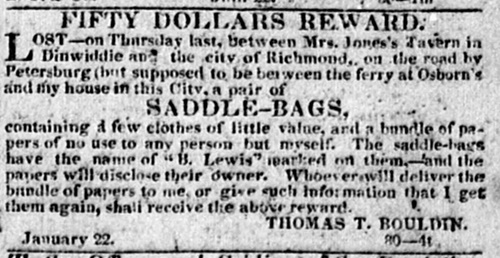
Toll House Location: South of Kukymuth Road on the right side of Osborne Turnpike just a few hundred yards beyond its intersection with Route 5 is the site of the Richmond and Osborne Turnpike toll house.

>Back to Top<
Military Action at Osborne Landing
On 27 April 1781, seven merchant ships and nine warships of the Virginia State Navy were assembled at Osborne's Landing when General Benedict Arnold arrived on the Chesterfield bank with British infantry regiments, the Queen's Rangers, Hessian Jaegers, two three-pound guns and two six-pound guns. Arnold sent a message to the American commander to surrender, "offering one half the contents of their cargoes in case they did not destroy any part." The American answered, "We are determined and will sink them rather than surrender." In response, Arnold's men sank all nine ships, including the Tempest, the Renown and the Jefferson, and captured the merchant ships along with 2,000 hogsheads of tobacco, flour, rope, and other supplies. John Simcoe's Sketch of the Action at Osburns shows the positions of the ships. Osborne Landing is near to top of the map.
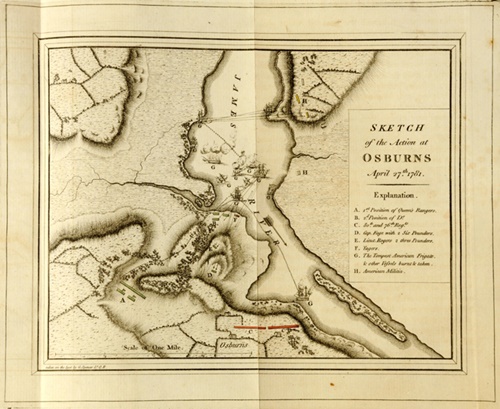
The 1864 map at the bottom shows the location of Confederate forces on the banks of the James River, and three wharves can be seen. One is on the left on the Chesterfield side, and two are on the right on the Henrico side. The topmost of those two appears to be Osborne's Landing.
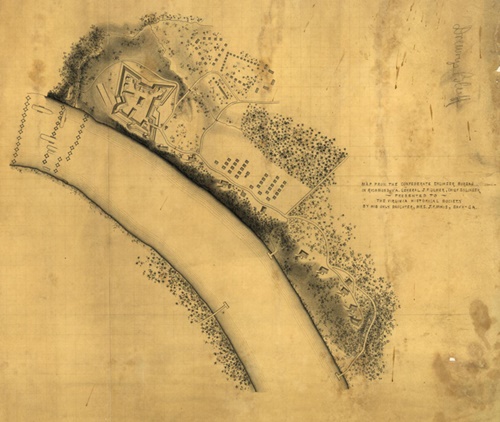
>Back to Top<
Now You know: Industrial Sand Box 'Toy'
But this toy produced objects that, for a while, would be too hot to handle. It's a wooden sand mold used in a foundry, and once again, we congratulate Mary Jo and Haywood Wigglesworth for correctly identifying the December "What do you know?" object.
To cast a metal three dimensional object, a mold would be pressed or pounded into a special wet sand in a molding box, or flask (as seen to the right). In early foundries a wooden pounder like that seen at the bottom right would be used. This created a negative space for half of a three-dimensional piece. This mold would be used twice, and the two flasks would be locked together. The top flask held what was called the "cope" and the bottom the "drag." Also included was a gating system designed to allow molten metal to be poured into the empty space between the two molds. Once the metal cooled, the flasks were removed, and the metal piece was retrieved.
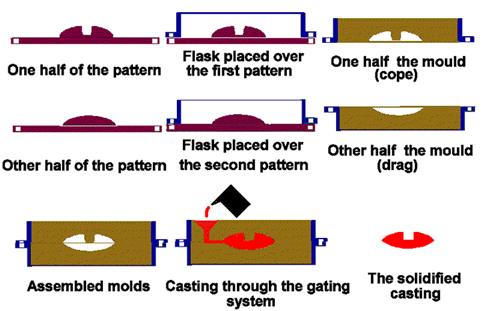
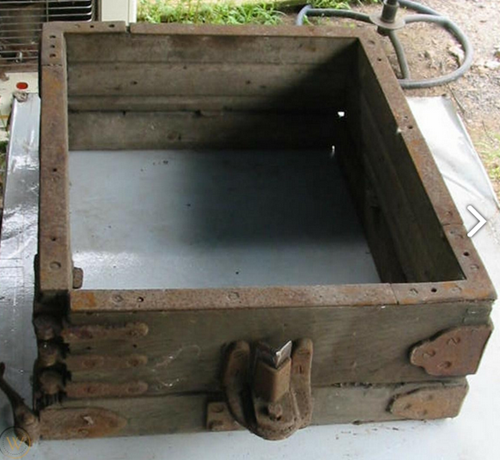
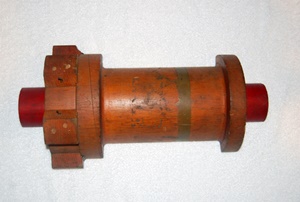

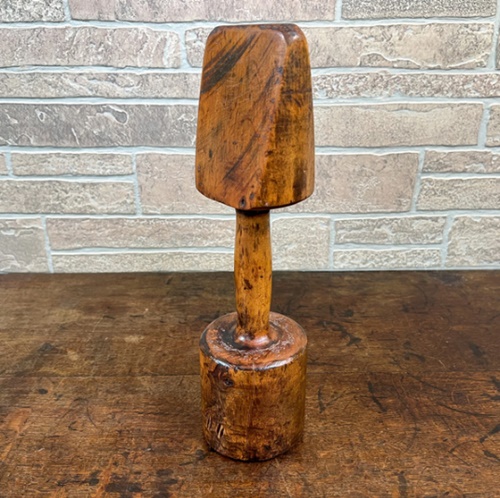
>Back to Top<
What Do You Know?
This metal object is 3" long and 2 1/4" wide. When the crank is turned, the two leather-covered cylinders inside spin in opposite directions, and the two-piece metal bar flips over.
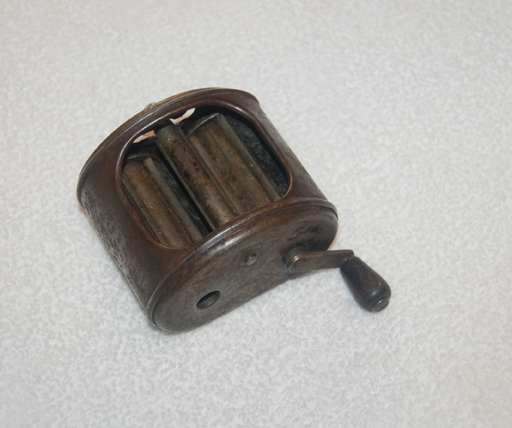

Do you know what it is? Email your answers to jboehling@verizon.net.
We look forward to hearing from you.
>Back to Top<
News 2023: First Quarter
Second Quarter | Third Quarter | Fourth Quarter
Home | Henrico | Maps | Genealogy | Preservation | Membership | Shopping | HCHS
|











